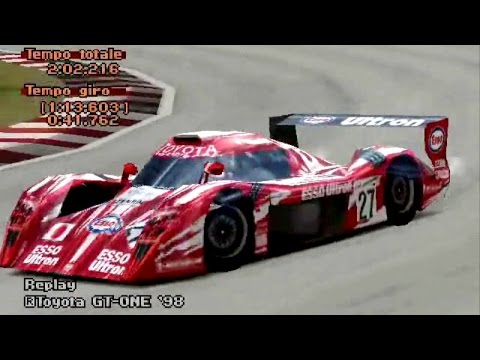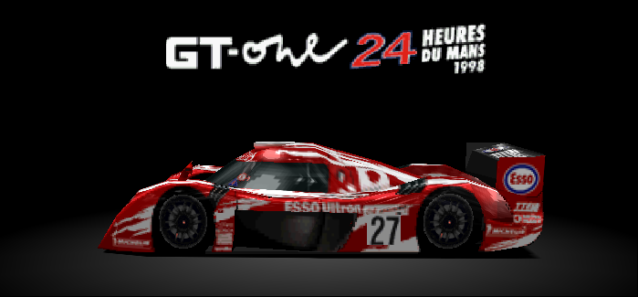- 716

- Chile
- cristobal458


The Toyota GT-One (model code TS020) is a racing car initially developed for grand touring GT1 rules, but later adapted into a Le Mans prototype LMGTP car. It raced in the 1998 and 1999 24 Hours of Le Mans.
Following the end of the Group C era around 1994, Toyota decided to alter its plans in sports car racing by moving to the production-based GT classes for 1995. Toyota decided to approach this in two ways by using two different styles of car for competition. The first was a heavily modified Toyota Supra, referred to as the Supra LM, which would use a turbocharged 3S-GT (503E) inline-4. The second entry was a custom built car designed specifically to be a racing car, yet required a small number of production cars for sale in order to meet homologation regulations. This car was modified heavily from the Toyota MR2, and became known as the SARD MC8-R. The MC8-R would use a custom built Toyota turbocharged V8. While the Supra performed admirably in 1995, the MC8-R would appear superior for 1996. With development of high powered supercars for the GT classes at the time, Toyota decided that a car similar to the MC8-R, which was intended as a race car first, would be better suited to continuing Toyota's development of a GT car. Thus Toyota announced they would skip the 1997 24 Hours of Le Mans to be able to develop their new GT car for 1998. (A MC8-R was entered for 1997 race, but failed to qualify).
Turning to Toyota's European arm based in Cologne, Germany, Toyota Team Europe (TTE) and Dallara were charged with development of the new GT car. With taking the one-year hiatus, TTE was able to look at what the competition was developing for the GT class, and exploit it to their benefit. In 1997, both the Mercedes-Benz CLK GTR and the Porsche 911 GT1 were dominant cars in their class that exploited loopholes in the rules in place at the time. Each car was a custom built super car of which only a small handful of production cars were built to homologate it. TTE realized that they would actually only need to build a single production car in order to meet homologation regulations, thus allowing TTE to have a car that would never truly be sold to a customer, meaning that any driver luxuries could be left out.
Second, Toyota learned about a loophole which Mercedes-Benz had exploited. All GT based cars were required to have storage space, capable of holding a standard sized suitcase, in order for the car to be considered not only production based, but usable by the public. Mercedes exploited this by putting a small cubby hole into an unused area underneath the rear bodywork, although it was not as easy to access as a normal trunk. Toyota, in their interpretation of the rules, were able to convince Automobile Club de l'Ouest (ACO) officials that the car's fuel tank, normally empty when the car is scrutineered before the race, was allowable as a trunk space since it could, theoretically, hold a suitcase.
With these loopholes in place, TTE was able to set out in laying-out the GT-One. TTE designed and manufactured the car's carbon fiber chassis and bodywork in-house, while Toyota supplied a heavily upgraded version of the engine they originally used on their Group C cars, the R36V 3.6 L Turbo V8.
TTE also developed the only two GT-One road cars built, required in order for the race car to qualify as a road car-based Grand Tourer. They were painted red and fitted with a basic interior. One was put into a museum in Japan, the other is displayed at Toyota Motorsport GmbH in Cologne, Germany.
Introduced in time for Le Mans in 1998, the GT-One first appeared at the official testing days for the race held in May. Three GT-Ones appeared, setting the 2nd, 5th, and 10th best times, easily beating out custom built prototypes which were meant to be the superior class. For the race week itself, all three cars performed admirably in qualifying by continuing their quick pace, qualifying 2nd, 7th, and 8th, being beaten only by their GT class competitor, Mercedes-Benz.
For the race itself, the #28 GT-One suffered from a high speed accident halfway through the race, taking it out of competition. The two other entrants continued to fight on, both remaining in the top 10. However, within the closing hours, the higher ranked #29 GT-One suffered a gearbox failure while in competition for the race win. Thus Toyota was left to take 9th place in the race with the lone #27 entry, which ended the race 25 laps behind the winning Porsche 911 GT1.
https://en.wikipedia.org/wiki/Toyota_GT-One
SPECIFICATIONS
OVERVIEW
• Manufacturer: Toyota
• Team: Toyota Motorsports
• Country: Japan
• Series: 24 Hours of Le Mans
• Class: GT1
• Year: 1998
• Type: Race car
• Division: Gr.2
ENGINE
• Engine: Toyota T836-9 (RV36V-R) V8/90°
• Power: 600 HP / 6000 rpm
• Torque: 650 Nm / --- rpm
• Engine location: Mid
• Displacement: 3579 cc
• Construction: Aluminium block and head
• Valvetrain: 4 valves / cylinder, DOHC
• Aspiration: Twin Garrett Turbos (T)
• Fuel feed: Direct fuel injection
PERFORMANCE
• 0-100 km/h (0-62 mph) Time: Unknown
• Top Speed: Over 330 km/h (205 mph)
• Power-to-weight ratio: <0.67 hp/kg
DRIVETRAIN
• Layout: MR
• Drive: Rear wheel drive
• Body: Carbon-fibre composite and Kevlar
• Chassis: Carbon-fibre and aluminium honeycomb monocoque with stressed engine
• Gearbox: TTE 6 speed Sequential
• Steering: Rack-and-pinion
• Suspension: Double wishbones
• Brakes: Ventilated carbon ceramic discs, all-round
DIMENSIONS & WEIGHT
• Lenght: 4840 mm
• Width: 2000 mm
• Height: 1125 mm
• Weight: +900 kg


Last edited: